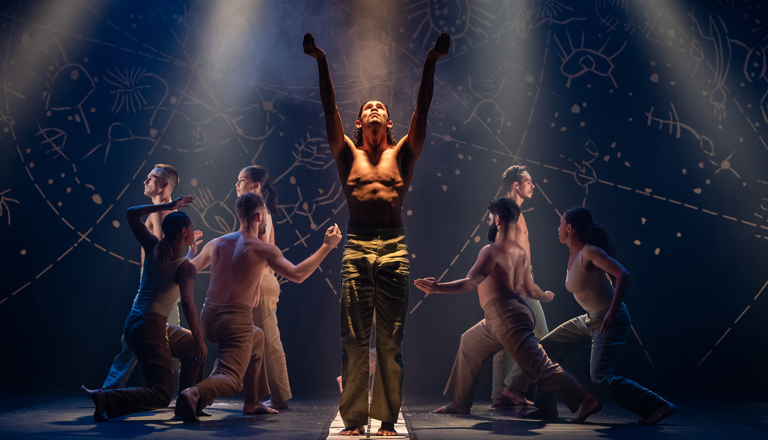Unaipon (2004)
Bringing the stories to the stage: the creative process
research and preparation
The creative process for making the work Unaipon started with extensive research and discussion with the Ngarrindgeri community. The work was first premiered in 2004 as part of the Clan program.
Rings first heard about Unaipon’s story from her sister, Gina Rings. “I thought the story would be a great subject for a dance work. and the more I found out about him the more I wondered why no one talks about this man?” People like Unaipon, Namatjira, Bennelong and Truganinni were people that were ‘in between’, they straddled Aboriginal and white culture, their sprits walked between two worlds with dignity and grace.
The historical record focuses on Unaipon’s achievements – his inventions, his role in Aboriginal political affairs, his profile as a celebrated figure in Australian history – however the reality of his situation as a man who could not travel freely, own property, earn money commensurate with his level of contributions is not well known.
We are very fortunate to have a great of deal of Unaipon’s own research and writing preserved and accessible, in particular his book, Legendary Tales of the Australian Aborigines, 1924, as well as illustrations of his inventions and patent licenses. However, as we learn more about Unaipon, it is important to be cognisant of the story behind the story, and be aware of his challenges and reality of times in which he lived.
dance practice
The dancing body inhabits the craft of the human movement, and communicates ‘in the moment’. Movement is the most natural way of telling how we feel, and how we question ourselves. Dance technique simply opens up the scope for choreography to stretch movement possibilities, add texture and inflection, and give the dance its own unique power.
Unaipon’s creative process is led by the choreographer, in close collaboration with cultural consultants, the dancers, the dramaturg, the composer of the music, and the costume, set and lighting designers. The people who take on these roles form the creative team. The creative team collaborates closely during the entire creative process to enable the dance to reflect the overall focus of the choreographer’s ideas.
The choreographer, the rehearsal director and the dancers work together in the dance studio for many hours each day over several weeks to create the choreographic vernacular and motifs for Unaipon. Together they invent movements that are inspired by the stories and the responses to being on country, developing their artistic interpretations to build dance sequences into a cohesive structure to the work.
dance skills
Using their dance technique and performance skills, the dancers work to blend the movements and make them clear, and technically achievable, before eventually settling on a final version of the choreography.
The rehearsal director is present throughout this process in order to rehearse the dance, so that the key qualities and details of the choreography as set by the choreographer are retained and remembered. As the work moves closer to its premiere date, the rehearsal director works with the dancers for many hours to make sure they can perform the dance consistently at the highest standard possible. At this point in the process, the technical elements of the designers – costume, set, and lighting – start to be incorporated.
dance production processes
In the week of the premiere performance, the dancers, rehearsal director, creative team and production crew move from the Bangarra dance studios to the theatre where they spend many hours rigging the set, positioning and programming the lighting, checking the sound levels and making necessary adjustments to the choreography to fit the space of the stage. This is called the ‘bump in’ and the production crew is largely responsible for coordinating this stage of the process. There is much excitement during this bump in week because no one has actually seen the finished work. How the work looks in the theatre is always different to the way it looks in the studio.
There is often a media call on the day of the premiere where photographers take pictures of the dancers in dress rehearsal, and journalists conduct interviews with the creative team. On premiere night reviewers will attend to write about the work for their respective newspapers, websites and blogs. These reviews are usually published as soon as possible after the premiere.
the life of a dance
During the lengthy process of creating a new Bangarra production, ideas will change and surprising shifts in the original plans will occur. This is the normal nature of the creative process, and probably one of the most exciting things about making a new work. Importantly, the elements that do not change are the traditional stories and original cultural elements, which always remain respected and intact. As the dance is performed over time, the story is passed from one dancer’s body to another as different dancers are taught the choreography.

